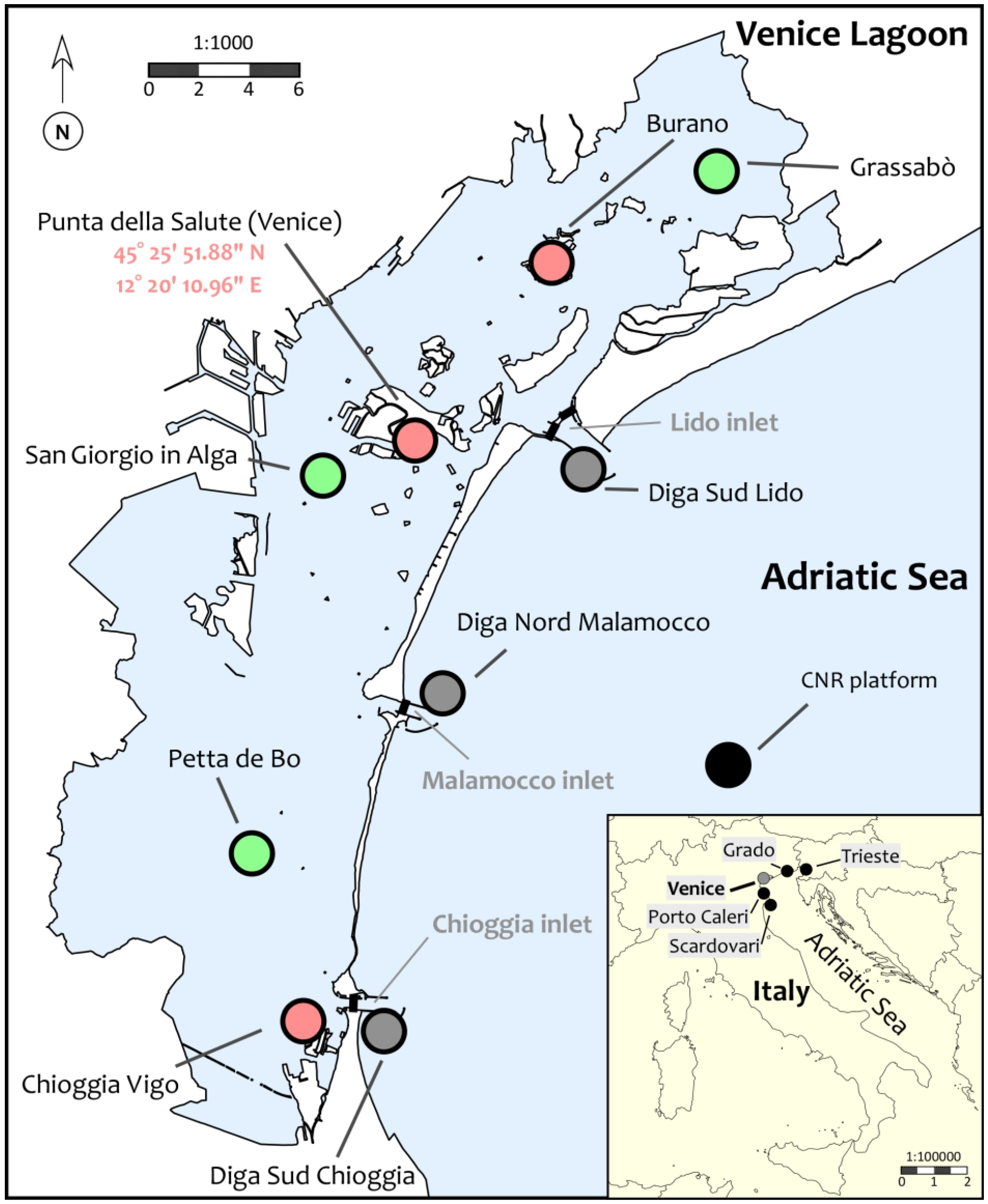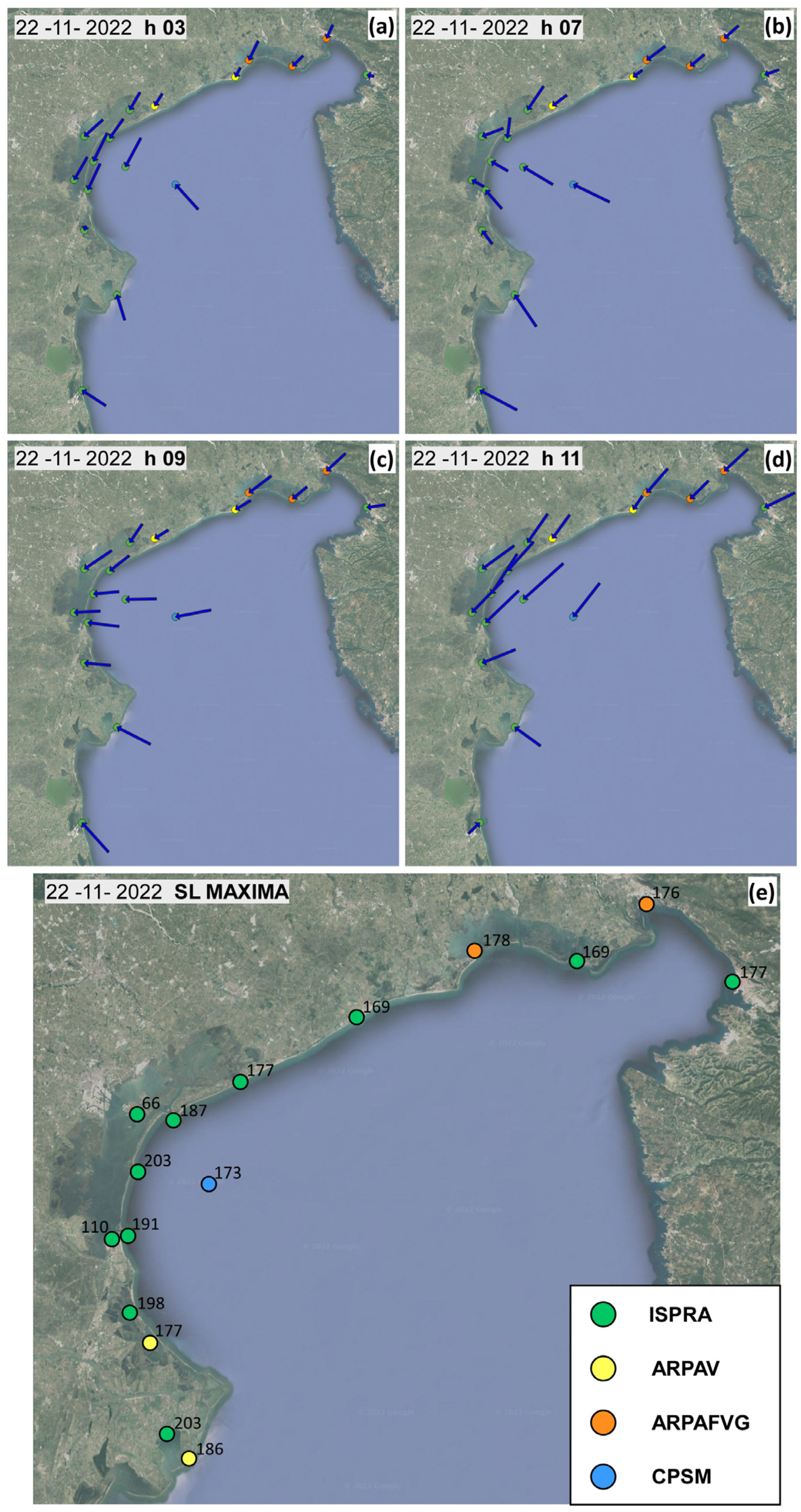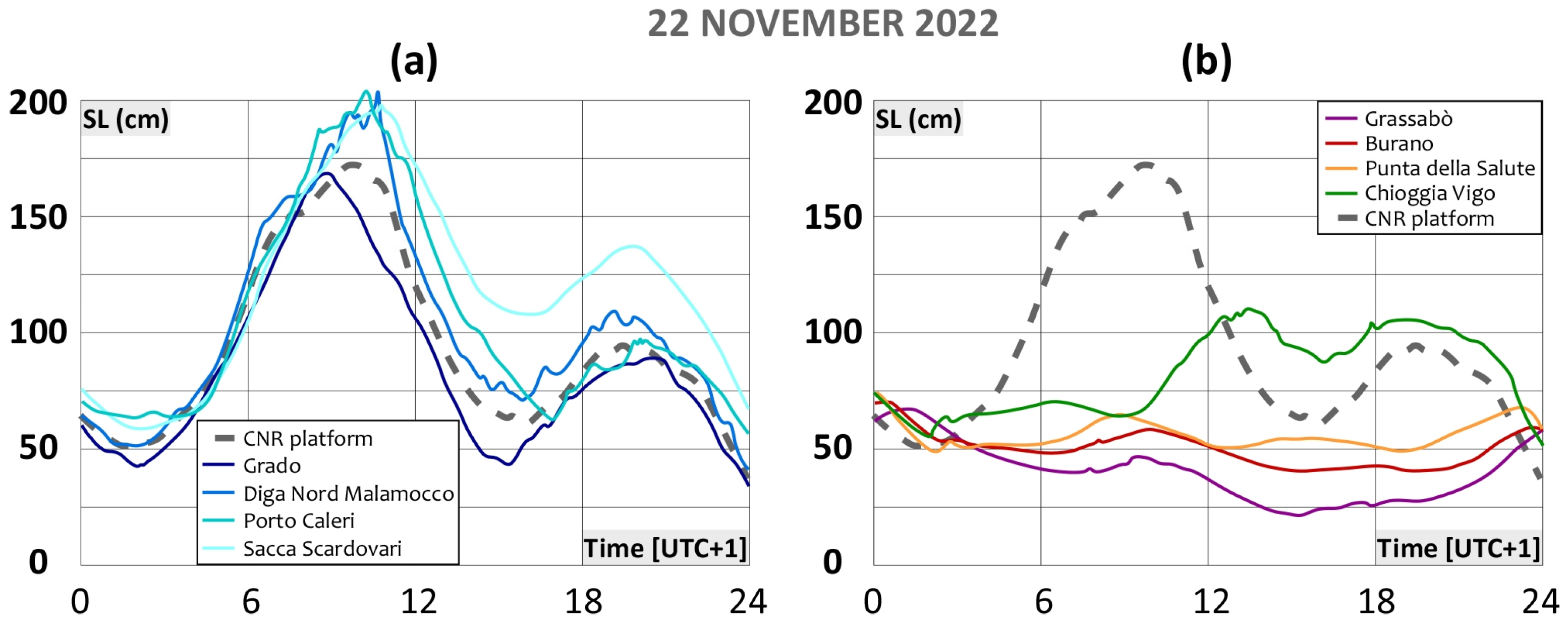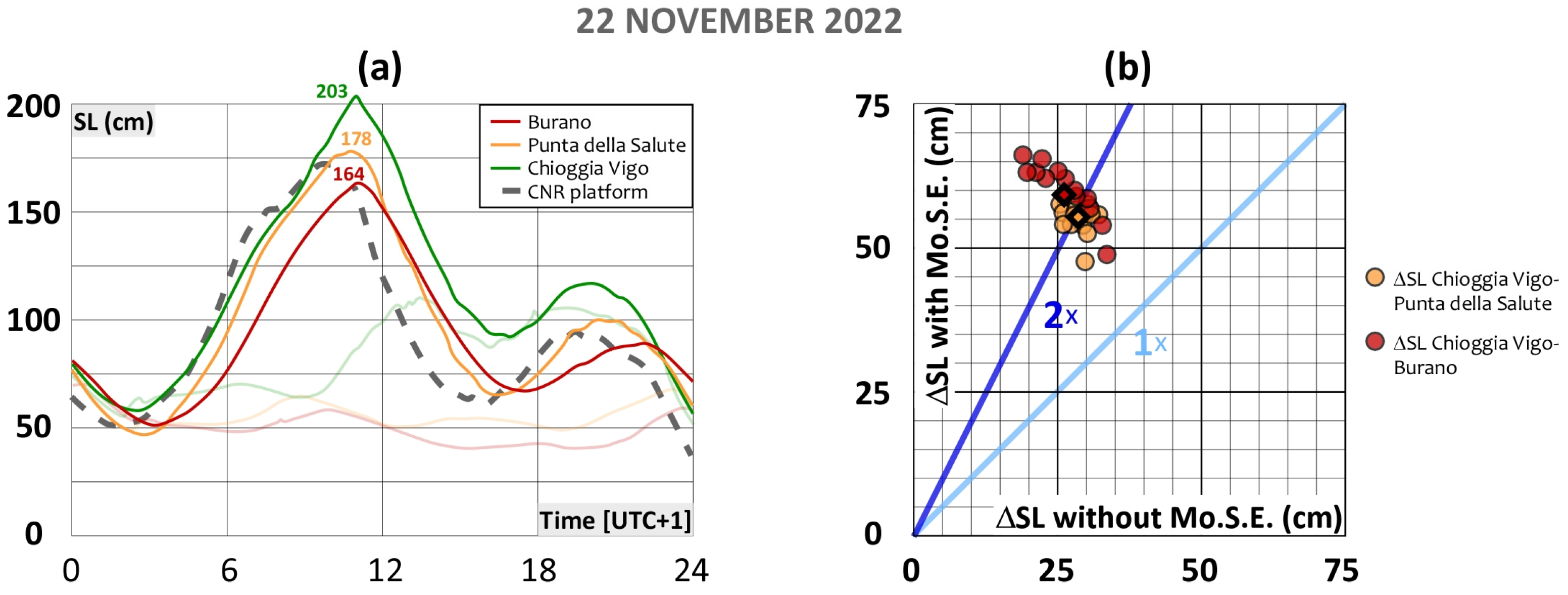Insights on the Extreme Storm Surge Event of the 22 November 2022 in the Venice Lagoon
Abstract
1. Introduction
2. Materials and Methods
2.1. The Study Area and the Flooding Barriers
2.2. The Flooding Barriers (Mo.S.E. System)
2.3. The Monitoring System
2.4. The WWTM Hydrodynamic Model and Simulation Setup
3. Results and Discussion
3.1. 22 November 2022—Analysis of the Event
3.2. 22 November 2022—The “What-If” Scenario
4. Conclusions
Author Contributions
Funding
Institutional Review Board Statement
Informed Consent Statement
Data Availability Statement
Conflicts of Interest
Appendix A
| No Event | Date CNR Platform | Peak Time (CET) CNR Platform | SL Peak (cm) CNR Platform | SL Peak (cm) Punta Della Salute | SL Peak Difference |
|---|---|---|---|---|---|
| 1 | 3 October 2020 | 11:10 | 119 | 77 | 42 |
| 2 | 15 October 2020 | 09:05 | 132 | 65 | 67 |
| 3 | 16 October 2020 | 09:15 | 111 | 53 | 58 |
| 4 | 2 December 2020 | 09:45 | 124 | 74 | 50 |
| 5 | 5 December 2020 | 00:50 | 122 | 81 | 41 |
| 6 | 5 December 2020 | 10:50 | 114 | 85 | 29 |
| 7 | 6 December 2020 | 00:45 | 120 | 87 | 33 |
| 8 | 6 December 2020 | 14:10 | 123 | 95 | 28 |
| 9 | 9 December 2020 | 08:10 | 113 | 84 | 29 |
| 10 | 10 December 2020 | 07:20 | 122 | 78 | 44 |
| 11 | 11 December 2020 | 06:45 | 124 | 77 | 47 |
| 12 | 12 December 2020 | 07:30 | 113 | 76 | 37 |
| 13 | 28 December 2020 | 10:10 | 128 | 75 | 53 |
| 14 | 30 December 2020 | 09:10 | 110 | 79 | 31 |
| 15 | 9 February 2021 | 08:30 | 116 | 103 | 13 |
| 16 | 10 February 2021 | 08:35 | 127 | 78 | 49 |
| 17 | 1 November 2021 | 20:55 | 123 | 83 | 40 |
| 18 | 2 November 2021 | 20:40 | 116 | 66 | 50 |
| 19 | 3 November 2021 | 19:55 | 132 | 60 | 72 |
| 20 | 6 November 2021 | 09:50 | 111 | 71 | 40 |
| 21 | 1 December 2021 | 07:25 | 117 | 77 | 40 |
| 22 | 2 December 2021 | 07:20 | 120 | 67 | 53 |
| 23 | 5 December 2021 | 09:10 | 113 | 72 | 41 |
| 24 | 9 December 2021 | 00:25 | 110 | 80 | 30 |
| 25 | 4 November 2022 | 08:40 | 113 | 74 | 39 |
| 26 | 5 November 2022 | 07:45 | 110 | 67 | 43 |
| 27 | 22 November 2022 | 09:40 | 173 | 67 | 106 |
| 28 | 23 November 2022 | 09:20 | 142 | 53 | 89 |
| 29 | 24 November 2022 | 09:00 | 134 | 65 | 69 |
| 30 | 25 November 2022 | 09:25 | 114 | 63 | 51 |
| 31 | 4 December 2022 | 07:10 | 121 | 72 | 49 |
| 32 | 16 December 2022 | 02:45 | 117 | 82 | 35 |
| 33 | 21 January 2023 | 08:30 | 124 | 70 | 54 |
| 34 | 22 January 2023 | 09:30 | 114 | 81 | 33 |
| 35 | 23 January 2023 | 10:45 | 135 | 61 | 74 |
| 36 | 28 August 2023 | 19:30 | 115 | 88 | 27 |
References
- Mel, R.A.; Carniello, L.; D’Alpaos, L. Addressing the effect of the Mo.S.E. barriers closure on wind setup within the Venice lagoon. Estuar. Coast. Shelf Sci. 2019, 225, 106249. [Google Scholar] [CrossRef]
- De Zolt, S.; Lionello, P.; Nuhu, A.; Tomasin, A. The disastrous storm of 4 November 1966 on Italy. Nat. Hazards Earth Syst. Sci. 2006, 6, 861–879. [Google Scholar] [CrossRef]
- Kortekaas, S.; Dawson, A.G. Distinguishing tsunami and storm deposits: An example from Martinhal, SW Portugal. Sediment. Geol. 2007, 200, 208–221. [Google Scholar] [CrossRef]
- Rodríguez-Ramírez, A.; Pérez-Asensio, J.N.; Santos, A.; Jiménez-Moreno, G.; Villarías-Robles, J.J.R.; Mayoral, E.; Celestino-Pérez, S.; Cerrillo-Cuenca, E.; López-Sáez, J.A.; León, A.; et al. Atlantic extreme wave events during the last four millennia in the Guadalquivir Estuary. SW Spain. Quat. Res. 2015, 83, 24–40. [Google Scholar] [CrossRef]
- Spencer, T. Submerging Coasts: The Effects of a Rising Sea Level on Coastal Environments; Bird, E.C.F., Ed.; John Wiley and Sons: Chichester, UK, 1993. [Google Scholar]
- Pirazzoli, P.A.; Umgiesser, G. The projected MOSE barriers against flooding in Venice (Italy) and the expected global sea-level rise. J. Mar. Environ. Eng. 2006, 8, 247–261. [Google Scholar]
- Ferrarin, C.; Valentini, A.; Vodopivec, M.; Klaric, D.; Massaro, G.; Bajo, M.; De Pascalis, F.; Fadini, A.; Ghezzo, M.; Menegon, S.; et al. Integrated sea storm management strategy: The 29 October 2018 event in the Adriatic Sea. Nat. Hazards Earth Syst. Sci. 2020, 20, 73–93. [Google Scholar] [CrossRef]
- Marcos, M.; Tsimplis, M.N.; Shaw, A.G.P. Sea level extremes in southern Europe. J. Geophys. Res. 2009, 144, C01007. [Google Scholar] [CrossRef]
- Prahl, B.F.; Boettle, M.; Costa, L.; Kropp, J.P.; Rybski, D. Damage and protection cost curves for coastal floods within the 600 largest European cities. Sci. Data 2018, 5, 180034. [Google Scholar] [CrossRef]
- Reimann, L.; Vafeidis, A.T.; Brown, S.; Hinkel, J.; Tol, R.S.j. Mediterranean UNESCO World Heritage at risk from coastal flooding and erosion due to sea-level rise. Nat. Commun. 2018, 9, 4161. [Google Scholar] [CrossRef]
- Taherkhani, M.; Vitousek, S.; Barnard, P.L.; Frazer, N.; Anderson, T.T.; Fletcher, C.H. Sea-level rise exponentially increases coastal flood frequency. Sci. Rep. 2020, 10, 6466. [Google Scholar] [CrossRef]
- Mel, R.A.; Lo Feudo, T.; Micieli, M.; Sinopoli, S.; Maiolo, M. A coupled wave-hydrodynamical model to assess the effect of Mediterranean storms under climate change: The Calabaia case study. Dyn. Atm. Ocean. 2023, 102, 101368. [Google Scholar] [CrossRef]
- Vousdoukas, M.I.; Mentaschi, L.; Hinkel, J.; Ward, P.J.; Mongelli, I.; Ciscar, J.-C.; Feyen, L. Economic motivation for raising coastal flood defenses in Europe. Nat Commun. 2020, 11, 2119. [Google Scholar] [CrossRef] [PubMed]
- Tognin, D.; Finotello, A.; D’alpaos, A.; Viero, D.P.; Pivato, M.; Mel, R.A.; Defina, A.; Bertuzzo, E.; Marani, M.; Carniello, L. Loss of geomorphic diversity in shallow tidal embayments promoted by storm-surge barriers. Sci. Adv. 2022, 8, eabm8446. [Google Scholar] [CrossRef] [PubMed]
- Mel, R.; Carniello, L.; Viero, D.P.; Defina, A.; D’Alpaos, L. The first operations of Mo.S.E. system to prevent the flooding of Venice: Insights on the hydrodynamics of a regulated lagoon. Estuar. Coast. Shelf Sci. 2021, 261, 107547. [Google Scholar] [CrossRef]
- Umgiesser, G. The impact of operating the mobile barriers in Venice (MOSE) under climate change. J. Nat. Conserv. 2020, 54, 125783. [Google Scholar] [CrossRef]
- Morucci, S.; Picone, M.; Nardone, G.; Arena, G. Tides and waves in the Central Mediterra-nean Sea. J. Oper. Oceanogr. 2016, 9 (Suppl. S1), s10–s17. [Google Scholar] [CrossRef]
- De Biasio, F.; Bajo, M.; Vignudelli, S.; Umgiesser, G.; Zecchetto, S. Improvements of storm surge forecasting in the Gulf of Venice exploiting the potential of satellite data: The ESA DUE eSurge-Venice project. Eur. J. Remote Sens. 2017, 50, 428–441. [Google Scholar] [CrossRef]
- Di Nunno, F.; Granata, F.; Gargano, R.; De Marinis, G. Forecasting of extreme storm tide events using NARX neural network-based models. Atmosphere 2021, 12, 512. [Google Scholar] [CrossRef]
- Granata, F.; Di Nunno, F. Artificial Intelligence models for prediction of the tide level in Venice. Stoch. Environ. Res. Risk Assess. 2021, 35, 2537–2548. [Google Scholar] [CrossRef]
- Umgiesser, G.; Bajo, M.; Ferrarin, C.; Cucco, A.; Lionello, P.; Zanchettin, D.; Papa, A.; Tosoni, A.; Ferla, M.; Coraci, E.; et al. The prediction of floods in Venice: Methods, models and uncertainty. Nat. Hazards Earth Syst. Sci. 2021, 21, 2679–2704. [Google Scholar] [CrossRef]
- Carniello, L.; Defina, A.; D’Alpaos, L. Morphological evolution of the Venice Lagoon: Evidence from the past and trend for the future. J. Geophys. Res. Earth Surf. 2009, 114, F04002. [Google Scholar] [CrossRef]
- Finotello, A.; Lanzoni, S.; Ghinassi, M.; Marani, M.; Rinaldo, A.; D’Alpaos, A. Migration rates of tidal meanders. Proc. Natl. Acad. Sci. USA 2018, 115, 1463–1468. [Google Scholar] [CrossRef] [PubMed]
- Molinaroli, E.; Guerzoni, S.; Sarretta, A.; Masiol, M.; Pistolato, M. Thirty-year changes (1970–2000) in bathymetry and sediment texture recorded in the lagoon of Venice sub-basins, Italy. Mar. Geol. 2009, 258, 115–125. [Google Scholar] [CrossRef]
- Mel, R. Exploring the partial use of the Mo.S.E. system as effective adaptation to rising flood frequency of Venice. Nat. Hazards Earth Syst. Sci. 2021, 21, 3629–3644. [Google Scholar] [CrossRef]
- Robinson, A.R.; Tomasin, A.; Artegiani, A. Flooding of Venice, phenomenology and prediction of the Adriatic storm surge. Q. J. R. Meteorol. Soc. 1973, 99, 688–692. [Google Scholar] [CrossRef]
- Mel, R.; Carniello, L.; D’Alpaos, L. How long the Mo.S.E. barriers will be effective in pro-tecting all urban settlements within the Venice Lagoon? The wind setup constraint. Coast. Eng. 2021, 168, 103923. [Google Scholar] [CrossRef]
- Cavaleri, L.; Bajo, M.; Barbariol, F.; Bastianini, M.; Benetazzo, A.; Bertotti, L.; Chiggiato, J.; Ferrarin, C.; Trincardi, F.; Umgiesser, G. The 2019 flooding of Venice and its implications for future predictions. Oceanography 2020, 33, 42–49. [Google Scholar] [CrossRef]
- Gentilomo, M.; Cecconi, G. Flood protection system designed for Venice. Hydropower Dams 1997, 2, 46–52. [Google Scholar]
- Mariani, S.; Casaioli, M.; Coraci, E.; Malguzzi, P. A new high-resolution BOLAM-MOLOCH suite for the SIMM forecasting system: Assessment over two HyMeX intense observation periods. Nat. Hazards Earth Syst. Sci. 2015, 15, 1–24. [Google Scholar] [CrossRef][Green Version]
- Morucci, S.; Coraci, E.; Crosato, F.; Ferla, M. Extreme events in Venice and in the North Adriatic Sea: 28–29 October 2018. Rend. Lincei Sci. Fis. Nat. 2020, 31, 113–122. [Google Scholar] [CrossRef]
- Defina, A. Two-dimensional shallow equations for partially dry areas. Water Resour. Res. 2000, 36, 3251. [Google Scholar] [CrossRef]
- Carniello, L.; Defina, A.; Fagherazzi, S.; D’Alpaos, L. A combined wind wave-tidal model for the Venice lagoon, Italy. J. Geophys. Res. 2005, 110, F04007. [Google Scholar] [CrossRef]
- Zarzuelo, C.; Lopez-Ruiz, A.; D’Alpaos, A.; Carniello, L.; Ortega-Sanchez, M. Assessing the morphodynamic response of human-altered tidal embayments. Geomorphology 2018, 320, 127–141. [Google Scholar] [CrossRef]
- D’Alpaos, L.; Defina, A. Mathematical modeling of tidal hydrodynamics in shallow lagoons: A review of open issues and applications to the Venice lagoon. Comput. Geosci. 2007, 33, 476–496. [Google Scholar] [CrossRef]
- Brocchini, M.; Wurtele, M.; Umgiesser, G.; Zecchetto, S. Calculation of a mass consistent two-dimensional wind-field with divergence control. J. Appl. Meteorol. 1995, 34, 2543–2555. [Google Scholar] [CrossRef]
- Carniello, L.; D’Alpaos, A.; Defina, A. Modeling wind-waves and tidal flows in shallow microtidal basins. Estuar. Coast. Shelf Sci. 2011, 92, 263–276. [Google Scholar] [CrossRef]
- Carniello, L.; Defina, A.; D’Alpaos, L. Modeling sandmud transport induced by tidal currents and wind waves in shallow microtidal basins: Application to the Venice Lagoon (Italy). Estuar. Coast. Shelf Sci. 2012, 102–103, 105–115. [Google Scholar] [CrossRef]
- Speranza, A.; Buzzi, A.; Trevisan, A.; Malguzzi, P. A Theory of Deep Cyclogenesis in the Lee of the Alps: Modifications of Baroclinic Instability by Localized Topography. J. Atmos. Sci. 1985, 42, 1521–1535. [Google Scholar] [CrossRef]
- Cavaleri, L.; Bajo, M.; Barbariol, F.; Bastianini, M.; Benetazzo, A.; Bertotti, L.; Chiggiato, J.; Davolio, S.; Ferrarin, C.; Magnusson, L.; et al. The October 29, 2018 storm in Northern Italy—An exceptional event and its modeling. Prog. Oceanogr. 2019, 178, 102178. [Google Scholar] [CrossRef]
- Buzzi, A.; Fantini, M.; Malguzzi, P.; Nerozzi, F. Validation of a limited area model in cases of Mediterranean cyclogenesis: Surface fields and precipitation scores. Meteorol. Atmos. Phys. 1994, 53, 53–67. [Google Scholar] [CrossRef]
- Malguzzi, P.; Grossi, G.; Buzzi, A.; Ranzi, R.; Buizza, R. The 1996 “century” flood in Italy. A meteorological and hydrological revisitation. J. Geophys. Res. 2006, 111, D24106. [Google Scholar] [CrossRef]






Disclaimer/Publisher’s Note: The statements, opinions and data contained in all publications are solely those of the individual author(s) and contributor(s) and not of MDPI and/or the editor(s). MDPI and/or the editor(s) disclaim responsibility for any injury to people or property resulting from any ideas, methods, instructions or products referred to in the content. |
© 2023 by the authors. Licensee MDPI, Basel, Switzerland. This article is an open access article distributed under the terms and conditions of the Creative Commons Attribution (CC BY) license (https://creativecommons.org/licenses/by/4.0/).
Share and Cite
Mel, R.A.; Coraci, E.; Morucci, S.; Crosato, F.; Cornello, M.; Casaioli, M.; Mariani, S.; Carniello, L.; Papa, A.; Bonometto, A.; et al. Insights on the Extreme Storm Surge Event of the 22 November 2022 in the Venice Lagoon. J. Mar. Sci. Eng. 2023, 11, 1750. https://doi.org/10.3390/jmse11091750
Mel RA, Coraci E, Morucci S, Crosato F, Cornello M, Casaioli M, Mariani S, Carniello L, Papa A, Bonometto A, et al. Insights on the Extreme Storm Surge Event of the 22 November 2022 in the Venice Lagoon. Journal of Marine Science and Engineering. 2023; 11(9):1750. https://doi.org/10.3390/jmse11091750
Chicago/Turabian StyleMel, Riccardo Alvise, Elisa Coraci, Sara Morucci, Franco Crosato, Michele Cornello, Marco Casaioli, Stefano Mariani, Luca Carniello, Alvise Papa, Andrea Bonometto, and et al. 2023. "Insights on the Extreme Storm Surge Event of the 22 November 2022 in the Venice Lagoon" Journal of Marine Science and Engineering 11, no. 9: 1750. https://doi.org/10.3390/jmse11091750
APA StyleMel, R. A., Coraci, E., Morucci, S., Crosato, F., Cornello, M., Casaioli, M., Mariani, S., Carniello, L., Papa, A., Bonometto, A., & Ferla, M. (2023). Insights on the Extreme Storm Surge Event of the 22 November 2022 in the Venice Lagoon. Journal of Marine Science and Engineering, 11(9), 1750. https://doi.org/10.3390/jmse11091750










